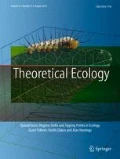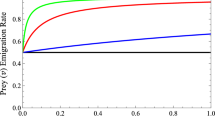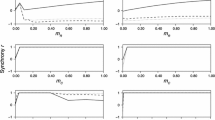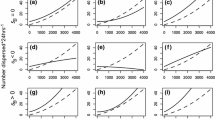Abstract
Antipredator behavior is known to have a strong effect on prey population dynamics. While there have been many studies of antipredator behavior in population dynamic models, none have examined how antipredator behavior interacts with predator foraging mode. To examine this process, we incorporated predator and prey velocities into a simple tritrophic food chain. In this model, antipredator behavior allows prey to respond to predators by slowing their velocity in response to predator density. Prey can slow their velocity to hide from predators, but this in turn reduces their ability to consume resources, creating a trade-off between hiding and foraging. We examined the effects of both fast-moving “mobile” predators and slow-moving “sit-and-wait” predators on equilibrium prey density and amplitude of predator-prey cycles. We found that antipredator behavior was ineffective against mobile predators, but it was very effective against sit-and-wait predators. Antipredator responses to sit-and-wait predators reduced top-down control and allowed prey density to increase with increased carrying capacity. Furthermore, antipredator responses to sit-and-wait predators eliminated population cycles within the community, whereas antipredator behavior had no effect on population cycles within mobile predator communities. Therefore, our model demonstrates predator foraging mode must be taken into account when examining predator-prey cycles. We discuss the potential implications of this model for invasive species and for trophic cascades.





Similar content being viewed by others
References
Abrams PA (1992) Predators that benefit prey and prey that harm predators: unusual effects of interacting foraging adaptation. Am Nat 140:573–600
Barraquand F, Louca S, Abbott KC, Cobbold CA, Cordoleani F, DeAngelis DL, Elderd BD, Fox JW, Greenwood P, Hilker FM, Murray DL, Stieha CR, Taylor RA, Vitense K, Wolkowicz GSK, Tyson RC (2017) Moving forward in circles: challenges and opportunities in modelling population cycles. Ecol Lett 20:1074–1092
Berger J (2010) Fear-mediated food webs. In: Terborgh J, Estes JA (eds) Trophic cascades: predators, prey and the changing dynamics of nature. Island Press, Washington, D.C., pp 241–253
Billings AC, Greene E, MacArthur-Waltz D (2017) Stellar’s jays assess and communicate about predator risk using detection cues and identity. Behav Ecol 28:776–783
Bishop MJ, Byers JE (2015) Predation risk predicts use of a novel habitat. Oikos 124:1225–1231
Blumstein DT (2006) The multipredator hypothesis and the evolutionary persistence of antipredator behavior. Ethology 112:209–217
Brown JS, Laundré JW, Gurung M (1999) The ecology of fear: optimal foraging, game theory, and trophic interactions. J Mammal 80:385–399
Calcagno V, Sun C, Schmitz OJ, Loreau M (2011) Keystone predation and plant species coexistence: the role of carnivore hunting mode. Am Nat 177:E1–E13
Carthey AJR, Banks PB (2016) Naiveté is not forever: responses of a vulnerable native rodent to its long term alien predators. Oikos 125:918–926
Carthey AJR, Blumstein DT (2018) Predicting predator recognition in a changing world. Trends Ecol Evol 33:106–115
Cox JG, Lima SL (2006) Naiveté and an aquatic–terrestrial dichotomy in the effects of introduced predators. Trends Ecol Evol 21:674–680
Davidson A, Griffin JN, Angelini C, Coleman F, Atkins RL, Silliman BR (2015) Non-consumptive predator effects intensify grazer-plant interactions by driving vertical habitat shifts. Mar Ecol Prog Ser 537:49–58
Dell AI, Pawar S, Savage VM (2014) Temperature dependence of trophic interactions are driven by asymmetry of species responses and foraging strategy. J Anim Ecol 83:70–84
Elton C, Nicholson M (1942) The ten-year cycle in numbers of the lynx in Canada. J Anim Ecol 11:215–244
Ferrari MCO, Crane AL, Brown GE, Chivers DP (2015) Getting ready for invasions: can background level of risk predict the ability of naïve prey to survive novel predators? Sci Rep 5:8309
Fritts TH, Rodda GH (1998) The role of introduced species in the degradation of island ecosystems: a case history of Guam. Annu Rev Ecol Syst 29:113–140
Grosholz ED, Ruiz GM, Dean CA, Shirley KA, Maron JL, Connors PG (2000) The impacts of a nonindigenous marine predator in a California bay. Ecology 81:1206–1224
Hastings A (1997) Population biology: concepts and models. Springer, New York
Hastings A, Powell T (1991) Chaos in a three-species food chain. Ecology 72:896–903
Holling CS (1959) Some characteristics of simple types of predation and parasitism. Can Entomol 91:385–398
Ives AR, Dobson AP (1987) Antipredator behavior and the population dynamics of simple predator-prey systems. Am Nat 130:431–447
Johnson CA, Amarasekare P (2015) A metric for quantifying the oscillatory tendency of consumer-resource interactions. Am Nat 185:87–99
Kauffman MJ, Brodie JF, Jules ES (2010) Are wolves saving Yellowstone’s aspen? A landscape-level test of a behaviorally mediated trophic cascade. Ecology 91:2742–2755
Kendall BE, Prendergast J, Bjørnstad ON (1998) The macroecology of population dynamics: taxonomic and biogeographic patterns in population cycles. Ecol Lett 1:160–164
Klemola T, Tanhuanpää M, Korpimäki E, Ruohomäki K (2002) Specialist and generalist natural enemies as an explanation for geographical gradients in population cycles of northern herbivores. Oikos 99:83–94
Leslie TW, van der Werf W, Bianchi FJJA, Honĕk A (2009) Population dynamics of cereal aphids: influence of a shared predator and weather. Agric For Entomol 11:73–82
Lima SL, Dill LM (1990) Behavioral decisions made under the risk of predation: a review and prospectus. Can J Zool 68:619–640
Louca S, Doebeli M (2015) Detecting cyclicity in ecological time series. Ecology 96:1724–1732
Luttbeg B, Trussell GC (2013) How the informational environment shapes how prey estimate predation risk and the resulting indirect effects of predators. Am Nat 181:182–194
Matassa CM, Trussell GC (2011) Landscape of fear influences the relative importance of consumptive and nonconsumptive predator effects. Ecology 92:2258–2266
McCann K, Yodzis P (1994) Biological conditions for chaos in a three-species food chain. Ecology 75:561–564
McLaren BE, Peterson RO (1994) Wolves, moose, and tree rings on Isle Royale. Science 266:1555–1558
Oksanen T, Henttonen H (1996) Dynamics of voles and small mustelids in the taiga landscape of northern Fennoscandia in relation to habitat quality. Ecography 19:432–443
Oksanen L, Fretwell SD, Arruda J, Niemelä P (1981) Exploitation ecosystems in gradients of primary productivity. Am Nat 118:240–261
Orrock JL, Grabowski JH, Pantel JH, Peacor SD, Peckarsky BL, Sih A, Werner EE (2008) Consumptive and nonconsumptive effects of predators on metacommunities of competing prey. Ecology 89:2426–2435
Packer C, Hilborn R, Mosser A, Kissui B, Borner M, Hopcraft G, Wilmshurst J, Mduma S, Sinclair ARE (2005) Ecological change, group territoriality, and population dynamics in Serengeti lions. Science 307:390–393
Peckarsky BL, Abrams PA, Bolnick DI, Dill LM, Grabowski JH, Luttbeg B, Orrock JL, Peacor SD, Preisser EL, Schmitz OJ, Trussell GC (2008) Revisiting the classics: considering nonconsumptive effects in textbook examples of predator-prey interactions. Ecology 89:2416–2425
Polis GA, Strong DR (1996) Food web complexity and community dynamics. Am Nat 147:813–846
Preisser EL, Bolnick DI, Benard MF (2005) Scared to death? The effects of intimidation and consumption in predator-prey interactions. Ecology 86:501–509
Preisser EL, Orrock JL, Schmitz OJ (2007) Predator hunting mode and habitat domain alter nonconsumptive effects in predator-prey interactions. Ecology 88:2744–2751
R Core Team (2017) R: a language and environment for statistical computing. R Foundation for Statistical Computing, Vienna
Ramos-Jiliberto R (2003) Population dynamics of prey exhibiting inducible defenses: the role of associated costs and density-dependence. Theor Popul Biol 64:221–231
Ramos-Jiliberto R, Mena-Lorca J, Flores JD, Morales-Álvarez W (2008) Role of inducible defenses in the stability of a tritrophic system. Ecol Complex 5:183–192
Reynolds PL, Bruno JF (2013) Multiple predators after prey behavior, population growth, and a trophic cascade in a model estuarine food web. Ecol Monogr 83:119–132
Rosenzweig ML, MacArthur RH (1963) Graphical representation and stability conditions of predator-prey interactions. Am Nat 97:209–223
Ross CT, Winterhalder B (2015) Sit-and-wait versus active-search hunting: a behavioral ecological model of optimal search mode. J Theor Biol 387:76–87
Ruohomäki K, Tanhuanpää M, Ayres MP, Kaitaniemi P, Tammaru T, Haukioja E (2000) Causes of cycliciy of Epirrita autumnata (Lepidoptera, Geometridae): grandiose theory and tedious practice. Popul Ecol 42:211–223
Scharf I, Nulman E, Ovadia O, Bouskila A (2006) Efficiency evaluation of two competing foraging modes under different conditions. Am Nat 168:350–357
Schmitz OJ (2008) Effects of predator hunting mode on grassland ecosystem function. Science 319:952–954
Schmitz OJ, Suttle KB (2001) Effects of top predator species on direct and indirect interations in a food web. Ecology 82:2072–2081
Sherbrooke WC (2008) Antipredator responses by Texas horned lizards to two snake taxa with different foraging and subjugation strategies. J Herpetol 42:145–152
Sih A (1987) Prey refuges and predator-prey stability. Theor Popul Biol 12:1–12
Sih A (1992) Prey uncertainty and the balancing of antipredator and feeding needs. Am Nat 139:1052–1069
Sih A, Bolnick DI, Luttbeg B, Orrock JL, Peacor SD, Pintor LM, Preisser E, Rehage JS, Vonesh JR (2010) Predator–prey naïveté, antipredator behavior, and the ecology of predator invasions. Oikos 119:610–621
Simberloff D (2013) Invasive species: what everyone needs to know. Oxford University Press, New York
Skellam JG (1958) The mathematical foundations underlying the use of line transects in animal ecology. Biometrics 14:385–400
Soetaert K (2009) rootSolve: nonlinear root finding, equilibrium and steady-state analysis of ordinary differential equations. R-package version 1.6
Soetaert K, Herman PMJ (2009) A practical guide to ecological modelling. Using R as a simulation platform. Springer
Soetaert K, Petzoldt T, Setzer RW (2010) Solving differential equations in R: package deSolve. J Stat Softw 33:1–25
Strong DR (1992) Are trophic cascades all wet? Differentiation and donor-control in speciose ecosystems. Ecology 73:747–754
Trussell GC, Ewanchuk PJ, Bertness MD (2002) Field evidence of trait-mdeiated indirect interactions in a rocky intertidal food web. Ecol Lett 5:241–245
Trussell GC, Matassa CM, Luttbeg B (2011) The effects of variable predation risk on foraging and growth: less risk is not necessarily better. Ecology 92:1799–1806
Vos M, Verschoor AM, Kooi BW, Wäckers FL, DeAngelis DL, Mooij WM (2004) Inducible defenses and trophic structure. Ecology 85:2783–2794
Werner EE, Anholt BR (1993) Ecological consequences of the trade-off between growth and mortality rates mediated by foraging activity. Am Nat 142:242–272
Werner EE, Peacor SD (2003) A review of trait-mediated indirect interactions in ecological communities. Ecology 84:1083–1100
Acknowledgments
We thank A. Hastings and A. Sih for their insightful comments on the manuscript. We also thank M. Baskett and V. Karatayev for sharing their technical expertise. JSS thanks S. Sadowski and C. Sadowski for their support in this project.
Funding
This material is based upon work supported by the National Science Foundation Graduate Research Fellowship under Grant No. (1650042) to JSS. Any opinions, findings, and conclusions or recommendations expressed in this material are those of the authors and do not necessarily reflect the views of the National Science Foundation.
Author information
Authors and Affiliations
Corresponding author
Electronic supplementary material
ESM 1
(DOCX 2035 kb)
Rights and permissions
About this article
Cite this article
Sadowski, J.S., Grosholz, E.D. Predator foraging mode controls the effect of antipredator behavior in a tritrophic model. Theor Ecol 12, 531–544 (2019). https://doi.org/10.1007/s12080-019-0426-3
Received:
Accepted:
Published:
Issue Date:
DOI: https://doi.org/10.1007/s12080-019-0426-3




